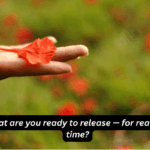Reconnect, repair, and reclaim the version of you that still needs your love.
What Is the “Inner Child”? (And Why It Matters)
Your “inner child” isn’t just a metaphor.
It’s the part of your subconscious that still holds the emotions, beliefs, and unmet needs from your early life experiences.
This part of you formed long before you could logically explain your pain — so it stored everything as felt truth:
- “I’m not safe.”
- “I have to be perfect to be loved.”
- “My needs don’t matter.”
- “It’s not okay to speak up.”
These beliefs live beneath your reactions, your fears, your relationships — even your burnout or self-sabotage.
Inner child healing is the process of going back and giving yourself what you didn’t get — safety, validation, nurturing, protection, and unconditional love.
It’s not about blaming parents or reliving the past.
It’s about reclaiming yourself — and learning to show up for the younger you who never stopped waiting.
Signs Your Inner Child May Need Healing
You might not even realize how often your wounded inner child is running the show.
Here are some signs:
- You overreact emotionally to small things
- You people-please to avoid conflict
- You’re afraid of being rejected or abandoned
- You feel unseen, even in relationships
- You numb or distract when things get hard
- You self-sabotage right when things are going well
- You struggle to trust yourself or feel “enough”
These aren’t character flaws — they’re coping mechanisms your inner child created to survive environments that didn’t feel safe.
Healing them begins by recognizing them.
Often, the reactions we label as ‘overreactions’ are actually emotional triggers rooted in childhood pain — understanding your emotional triggers can reveal the younger parts of you that still need to feel safe.
Where Does the Inner Child Get Wounded?
The wounds of your inner child often come from:
- Emotional neglect (“No one cared how I felt”)
- Being shamed for crying or having needs
- Witnessing or experiencing conflict, chaos, or abuse
- Being parentified (having to “be the adult” too young)
- Not feeling safe to express anger, sadness, or fear
- Always being told to “be good,” “be quiet,” or “grow up”
Even if your parents did their best — your emotional needs might have gone unmet.
And those unmet needs don’t disappear… they wait.
How to Begin Healing Your Inner Child (Step by Step)
Inner child work is gentle.
It’s slow.
It’s a homecoming, not a quick fix.
Here’s how to start:
1. Create Space to Connect
You can’t heal what you’re too busy to feel.
Start small:
- Light a candle
- Sit in stillness for 5–10 minutes
- Imagine your younger self walking into the room
Ask yourself:
- “How old is this version of me?”
- “What is she feeling right now?”
- “What does she need?”
You don’t have to “know” the answers. Just listen.
2. Acknowledge the Pain Without Judging It
This is not about blaming your parents.
It’s about validating your own pain.
You can hold both:
“They did the best they could.”
And
“What I needed wasn’t there — and that mattered.”
Write a letter to your younger self starting with:
- “You never should’ve had to…”
- “I’m sorry no one ever told you…”
Let her be angry. Let her cry. Let her speak.
3. Speak to Your Inner Child Daily
Inner child healing isn’t a one-time journal session.
It’s a daily reparenting practice.
Try saying:
- “You’re safe now.”
- “You didn’t do anything wrong.”
- “I’ll never abandon you again.”
- “I love who you are.”
Say it in the mirror. Whisper it during meditation.
You’re teaching your nervous system a new truth.
Inner child work and emotional resilience go hand-in-hand — this gentle guide to sitting with difficult emotions can help you stay present with what arises as you reconnect with yourself.
4. Give Yourself What You Missed
This is the repair.
Ask:
“What didn’t I get as a child — and how can I give it to myself now?”
Some examples:
- If you needed affection → give yourself loving touch, blankets, self-hugs
- If you needed freedom → let yourself play, explore, color outside the lines
- If you needed to be heard → journal, voice-note, talk to a coach or therapist
- If you needed protection → set boundaries, say no, take up space
You become the parent your inner child needed.
5. Watch Your Triggers With Curiosity, Not Shame
When you’re triggered, ask:
- “How old do I feel right now?”
- “What did I need back then that I didn’t get?”
Most adult overreactions are your inner child yelling:
“This feels familiar — and it still hurts.”
Meeting that voice with love instead of shame is one of the most powerful shifts you can make.
Inner Child Healing Journal Prompts
Here are some prompts to explore in your own time:
- “When I was little, I needed more…”
- “The first time I felt invisible was…”
- “I learned to keep myself safe by…”
- “I’m proud of the child I was because…”
- “What would I say to 8-year-old me right now?”
Use these to deepen your connection and create emotional safety.
Final Thoughts: You’re Not Behind. You’re Becoming.
Your inner child doesn’t need you to fix her.
She needs you to find her.
She doesn’t want you to be perfect.
She wants you to come close. To say:
“I see you. I hear you. I’m not leaving.”
This work is slow. Messy. Brave.
But every time you pause to feel, breathe, and care for yourself,
you’re not just healing old wounds — you’re rewriting your future.
And she — your inner child — has been waiting for this moment.
Welcome home.



